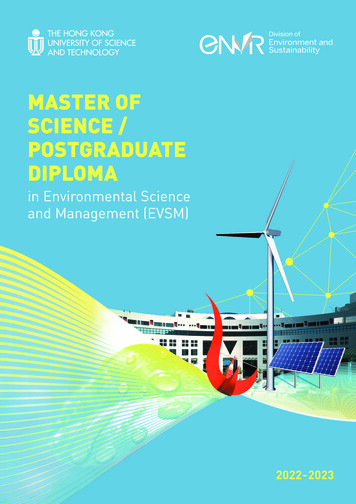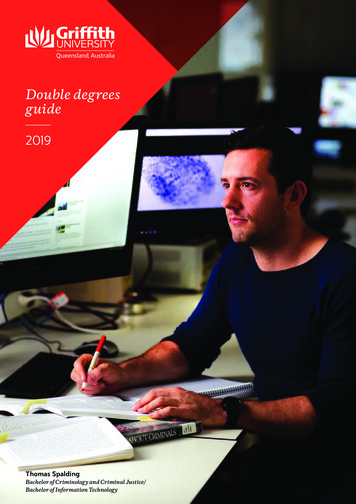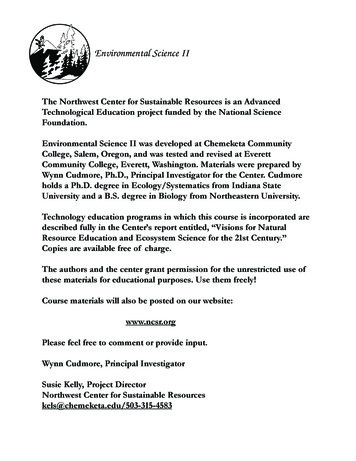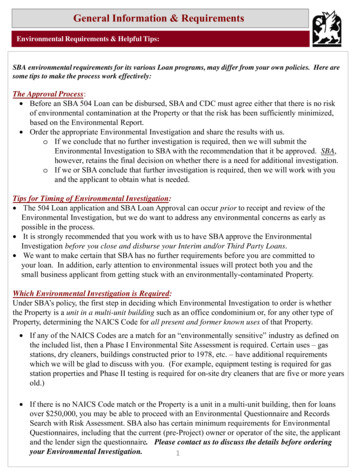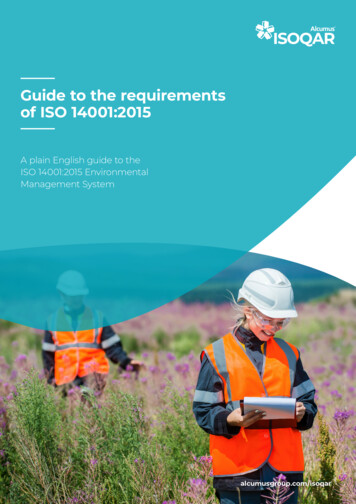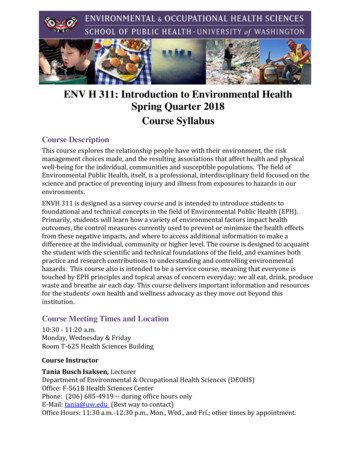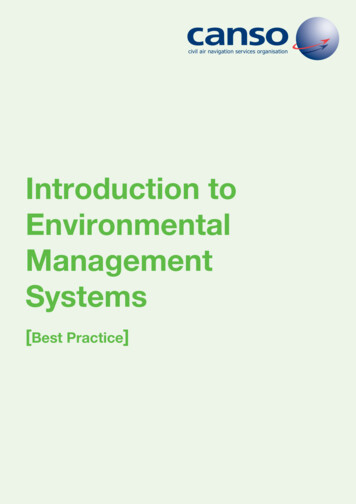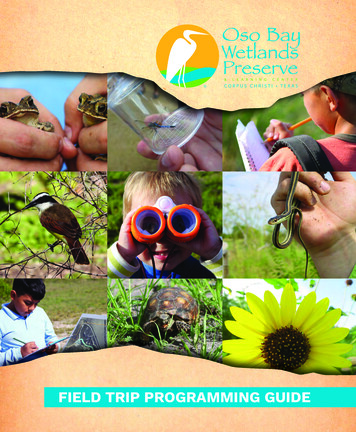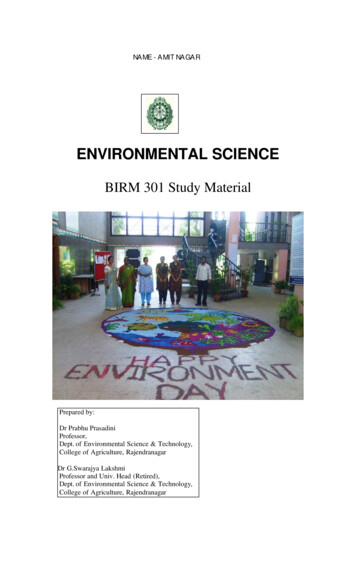
Transcription
NAME - AMIT NAGARENVIRONMENTAL SCIENCEBIRM 301 Study MaterialPrepared by:Dr Prabhu PrasadiniProfessor,Dept. of Environmental Science & Technology,College of Agriculture, RajendranagarDr G.Swarajya LakshmiProfessor and Univ. Head (Retired),Dept. of Environmental Science & Technology,College of Agriculture, Rajendranagar
CONTENTSS.No.Chapter1Multidisciplinary nature of EnvironmentalStudies2Natural Resources3Biodiversity4Environmental Pollution5Nuclear Hazards and Waste management6Disaster management7Social issues and the Environment8Environmental acts9ReferencesPage No.
REFERENCESAnjaneyalu, Y. 2004. Introduction to Environmental Science. BS Publications,Hyderabad, A.P. India.Anji Reddy, M. Text book of Environmental Science and Technology, BS Publications,HyderabadBenny Joseph. 2006. Environmental Science and Engineering, Tata Mc-Graw HillPublishing Company, New Delhi.Cunningham, W.P., Cooper, T.H., Gorhani, E and Hepworth, M.T. 2001. EnvironmentalEncyclopedia, Jaico Publ. House, Mumbai, 1196p.Down to earth published by Centre For Science And Environment.Erach Bharucha. 2005. Text book of Environmental Studies for undergraduate courses,University Grants Commission, New Delhi.Gupta, P.K. 2004. Methods in Environmental analysis –water, soil and air. Published byAgrobios (India), Jodhpur.Kaul, S.N. and Ashutosh Gautam. 2002. Principles of Environmental Studies. DayaPublishing house, New Delhi.Manoharachary, C. and P. Jayaramareddy 2009. Principles of environmental studies(ecology, economics, management and law), BS publications, Hyderabad.Sharma, R.C. and D. Gurbir Sangha 2006. Environmental studies. Kalyani publishers,New Delhi.Sushmitha Baskar and R.Baskar . 2007. Environmental studies for under graduatecourses. Published by Unicon books, Delhi.Swarajya Lakshmi, G., Prabhu Prasadini, P., Ramesh Thatikunta and VNLV Tayaru.2010. Environmental Science A Practical Manual, BS publications, HyderabadVidyasagar R and Prabhu Prasadini 2008. Objective Questions and Glossary inEnvironmental Science, BS publications, Hyderabad.Web site: http://en.wikipedia.orgMultidisciplinary nature of Environmental StudiesThe word environment is derived from the French verb ‘environner’ which meansto ‘encircle or surround’. Thus our environment can be defined as the physical, chemicaland biological world that surround us as well as the complex of social and culturalconditions affecting an individual or community. This broad definition includes thenatural world and the technological environment as well as the cultural and socialcontexts that shape human lives. It includes all factors living and nonliving that affect anindividual organism or population at any point in the life cycle; set of circumstancessurrounding a particular occurrence and all the things that surrounds us.Objective of this course is to develop concern for our own environment whichwill lead us to act at our own leve l to protect the environment we all live in. There arethree reasons for studying the state of the environment. The first,is the need forinformation that clarifies modern environmental concepts like equitable use of natural
resources, more sustainable life styles etc. Second, there is a need to change the way inwhich we view our own environment, using practical approach based on observation andself learning. Third, there is a need to create a concern for our environment that willtrigger pro-environmental action, including simple activities we can do in our daily life toprotect it.Environmental science is essentially the application of scientific methods andprinciples to the study of environmental issues, so it has probably been around in someforms as long as science itself. Environmental science is often confused with other fieldsof related interest, especially ecology, environmental studies, environmental educationand environmental engineering. Environmental science is not constrained with any onediscipline and it is a comprehensive field.Environmental science is not ecology though that discipline may be included.Ecologists are interested in the interactions between some kind of organisms and itssurroundings. Most ecological research and training does not focus on environmentalproblems except as those problems impact the organism of interest. Environmentalscientists may or may not include organisms on their field of view. They mostly focus onthe environmental problem which may be purely physical in nature. For eg. Aciddeposition can be studied as a problem of emissions and characteristic of the atmospherewithout necessarily examining its impact on organisms.There are two types of environments:1.Natural environment2.Man made environmentNatural: The environment in its original form without the interference of human beingsis known as natural environment. It operates through self regulating mechanism calledhomeostasis i.e, any change in the natural ecosystem brought about by natural processesis counter balanced by changes in other components of environment.Man made or Anthropogenic Environment: The environment changed or modified bythe interference of human beings is called man made environment. Man is the mostevolved creature on this earth. He is modifying the environment according to hisrequirements without bothering for its consequences. Increased technologies andpopulation explosion are deteriorating the environment more and more.Scope of environmental studies:Because, the environment is complex and actually made up of many differentenvironments, including natural, constructed and cultural environments, environmentalstudies is the inter disciplinary examination of how biology, geology, politics policystudies, law, geology, religion engineering, chemistry and economics combine to informthe consideration of humanity’s effects on the natural world. This subject educates thestudents to appreciate the complexity of environmental issues and citizens and experts inmany fields. By studying environmental science, students may develop a breadth of theinterdisciplinary and methodological knowledge in the environmental fields that enablesthem to facilitate the definition and solution of environmental problems.
The scope of environmental studies is that, the current trend of environmentaldegradation can be reversed if people of educated communities are organized andempowered; experts are involved in sustainable development. Environmental factorsgreatly influence every organism and their activities. The major areas in which the role ofenvironmental scientists are of vital importance are natural resources, ecosystems,biodiversity and its conservation, environmental pollution, social issues and environmenthuman population and environment.It is essentially a multidisciplinary approach and its components includeBiology, Geology, Chemistry, Physics, Engineering, Sociology, Health Sciences,Anthropology, Economics, Statistics and Philosophy It is essentially a multidisciplinaryapproach. An Understanding of the working of the environment requires the knowledgefrom wide ranging fields. The table below shows a list of topics dealt commonly in airpollution and the related traditional fields of knowledge illustrating the interdisciplinarynature of the subject.Table: Interdisciplinary Nature of Environmental Science Ex:Air PollutionEnvironmental issue/topicsMajor subject/Topic knowledge requiredNature and reaction of air pollutantsChemistry and Chemical engineeringEffects of air pollutants on humanZoology and botany and various branches ofbeings, animals and plantslife science. Physics and ChemistryEffect of air pollutants on materialsMeteorology, Thermodynamics, GeographyEffect of climate on air pollutionMathematical modeling, etc.Air pollution control devicesPhysics, chemistry and various branches ofEngineeringHistory of air pollution and airHistorypollution episodesEconomic impacts of air pollutionEconomics, DemographySociological impacts of air pollutionSociologyAlternative fuelsVarious branches of physical sciencesConservation of resources and pollutionVarious branches of physical and politicalcontrolsciencesOzone hole and global warmingAlmost all fields under the sun has gotsomething to contribute to the understandingand prevention of these phenomenon.Importance of environmental education:Environment is not a single subject, it is an integration of several subjects thatinclude both science and social studies. To understand all the different aspects of ourenvironment, we need to understand biology, chemistry, physics, geography, resourcesmanagement, economics, and population issues. Thus, the scope of environmental studiesextremely wide and covers some aspects of nearly every ma jor discipline.We live in a world where natural resources are limited. Water, air, soil,minerals, oils, the products we get from forests, grasslands, oceans and from agricultureand live stock, are all a part of our life support systems. Without them, life itself would be
impossible. If we use them more and more, the earth’s resources must inevitably shrink.The earth cannot be expected to sustain indefinitely due to over utilization of resources,misuse of resources. We waste or pollute large amount of clean water. We discard plastic,solid wastes and liquid wastes from industries which cannot be managed by naturalprocesses. These accumulate in our environment, leading to a variety of diseases andother adverse environmental impacts, now seriously affe cting all our lives. Air pollutionleads to respiratory diseases, water pollution to gastro – intestinal diseases and manypollutants are known to cause cancer.This situation will only improve if each of us begins to take action in our dailylives that will help to preserve our environmental resources. We cannot expectGovernment alone to manage the safeguarding of the environment, nor we can expectother people to prevent environmental damage. We need to do it ourselves. It is aresponsibility that each of us must take on as one’s own.Environmental Issues of Global ConcernThe main environmental issues today are wide ranging and all-encompassing aredeforestation, biodiversity, soil erosion, climate change, pesticide build-up, industrial andmunicipal pollution. All these problems can be categorized into three main issues:1. Population explosion2. Land degradation3. Environmental pollution: Industrialization, agriculture/fertilizer/pesticide/greenhouse gases, air pollution, acid rain, ozone depletion, green house effect, waterpollution and deforestation.Environmental problems in India can be put into three classes: Poverty,problems arising as negative effects of the very process of development and problemsarising from improper implementation of the directives and laws of environmentalprotectionValues of Nature: This can be discussed under three categories i.e. i) Productive value,ii) Aesthetic value or recreational value and iii) Option valueProductive value of nature : Worlds’ species contain an incredible and unaccountablenumber of complex chemicals. These are raw materials used for developing newmedicines and industrial products. When we permit the destruction of a forest, wet landor other natural area and do not protest about it, future generations are being denied theuse of these valuable resources. Thus the urgent need to protect all living species is aconcept that we need to understand and act upon. There is close link between agricultureand the forest, which illustrates its productive value. For crops to be successful, theflowers of fruit trees and vegetables must be pollinated by insects and birds. Their lifecycle frequently require intact forests.Aesthetic/ recreational value of nature : Nature encompasses every aspect of living(biodiversity: flora and fauna) and non- living (sea, desert) part of the earth and itenlivens our existence on earth. This is created by developing national parks and wildlifesanctuaries in relatively undisturbed areas. In an Urban setting, there will be green spacesand gardens – psychological and physical health of city dwellers and provides aesthetic
value and visual appeal. It also gives access to certain amount of peace. Nature tourism orwildlife tourism or eco tourism is a pleasurable experience and also creates a deep respectand love for nature.The option value of nature :Nature provides us with various options on how we utilize its goods andservices. This is its option value. We can use up goods and services greedily and destroyits integrity and long term values or we can use its resources sustainably and reduce ourimpact on environment. The option value allows us to use its resources sustainable andpreserve its goods and services for the future. “The earth provides enough to satisfiyevery persons need but not every persons greed” is the vision of Mahatma Gandhiji.Need for public awareness:As the earth’s natural resources are rapidly dwindling and our environment isbeing increasingly degraded by human activities, it is evident that some thing needs to bedone.The following measures may help for the environmental awareness.1. Join a group to study nature, such as WWF-1 or BNHS or another environmentalgroup2. Begin reading news paper articles and periodicals like Down to Earth, WWF-1 Newsletter, BNHS, Hornbill, Sanctuary magazine etc which will tell you more about ourcurrent environmental issues. There are also several environmental websites.3. Lobby for conserving resources by taking up the cause of environmental issues duringdiscussions with friends and relatives. Practice and promote issues such as savingpaper, saving water, reducing use of plastic, practicing the 3Rs principle of reduce,reuse, recycle and proper waste disposal.4. Join local movements that support activities like saving trees in your area, go onnature treks, recycle waste, buy environmentally friendly products.5. Practice and promote good civic sense and hygiene such as enforcing no spitting ortobacco chewing, no throwing garbage on the road, no smoking in public places, nourinating or defecating in public places.6. Take part in events organized on World Environment Day, Wildlife Week etc.7. Visit a National Park or Sanctuary or spend time in whatever natural habitat you havenear your home.Institutions in environmentManaging natural resources require efficient institutions at all levels i.e. local,national, regional and global. Institutions, as defined by Young (1999), are systems ofrules, decision- making procedures, and programs that give rise to social practices, assignroles to participants in these practices, and guide interactions among theoccupants of therelevant roles. Institutions often figure prominently in efforts to solve or manageenvironmental problems. Several Government and Non- Government Organizations(NGO’S) are working towards environmental protection in our country. They playa roleboth in causing and in addressing problems arising from human-environment interactions.They
have led to a growing interest in environmental protection and conservation of nature andnatural resources. Among the large number of institutions that deal with environmentalprotection and conservation, a few well-known organization include governmentorganizations like the BSI and ZSI, and NGOs like the BNHS, WWF-1, etc.The Bombay Natural History Society (BNHS), Mumbai: It was founded on 15September 1883, is one of the largest non-governmental organizations in India engagedin conservation and biodiversity research. It supports many research efforts throughgrants, and publishes a popular magazine called the Hornbill and also an internationallywell-known the Journal of the Bombay Natural History Society. Its other publicationsinclude salim Ali’s Handbook on Birds, JC Daniel Book of Indian reptiles. SH Prater’sbook of Indian mammals and PV Bole’s book of Indian trees. Many prominentnaturalists, including the ornithologists Sálim Ali and S. Dillon Ripley have beenassociated with it. The BNHS has over the years helped the government to framewildlife-related laws and has taken up battles such as the ‘save the silent valley’campaign.World Wide fund for nature - India (WWF-1), New Delhi: The WWF-1 was initiatedin 1969 in Mumbai, after which the headquaters were shifted to Delhi with several State,Divisional and Project offices spread across India. In the early years it focused attentionon wildlife education and awareness. It runs several programs, including the nature clubsof India program for school children and works as a think –tank and lobby force forenvironmental and development issues.Centre or science and environment (CSE), New Delhi: is a public interest researchand advocacy organisation based in New Delhi. CSE researches into, lobbies for andcommunicates the urgency of development that is both sustainable and equitable. It haspublished a major document on the State of India’s Environment, the first of its kind tobe produced as a citizen’s Report on the environment. It also publishes a popularmagazine, Down to Earth which is a science and environment fortnightly. It is involvedin the publication of material in the form of books posters, video films and also conductsworkshops and seminars on biodiversity- related issues. The Centre’s efforts are builtaround five broad programmes: Communication for Awareness, Research and Advocacy,Education and Training, Knowledge Portal and Pollution Monitoring.C.P.R Environmental Education Centre, Madras: the CPR-EEC was set up in 1988CPREEC) is a Centre of Excellence of the Ministry of Environment and Forests (MoEF),Government of India, established jointly by the Ministry and the C.P. Ramaswami AiyarFoundation. It conducts a variety of programs to increase awareness and knowledge ofpublic i.e., school children, local communities, woman as main key target groups aboutthe various aspects of environment Its programs include components on wildlife andbiodiversity issues. CPR-EEC also publishes large number of text books for schoolchildren and video-on wheels for rural public. The C. P. R. Environmental EducationCentre received the Indira Gandhi Paryavaran Puraskar for the year 1996.
The Centre for Environment Education (CEE) in India was established in August 1984as a Centre of Excellence supported by the Ministry of Environment and Forests. Theorganisatio n works towards developing programmes and materials to increase awarenessabout the environment and sustainable development. The head office is located inAhmedabad. The Centre has 41 offices including regionalcells and several field offices,across India. It has international offices in Australia, Bangladesh and Sri Lanka. CEE'sprimary objective is to improve public awareness and understanding of the environmentwith a view to promoting the conservation and sustainable useof nature and naturalresources, leading to a better environment and a better quality of life. To this end, Itundertakes demonstration projects in education, communication and development thatendorse attitudes, strategies and technologies which are environmentally sustainable.CEE is committed to ensuring that due recognition is given to the role of education in thepromotion of sustainable development.Bharati Vidyapeeth University, Institute of Environment Education & Research,Pune was established in 1993.This is part of the Bharati Vidyapeeth deemed University.Its major focus is to spread the message of the need for pro-environmental action insociety at large through a dual strategy of formal and non –formal integrated activities.BVIEER is a one of a kind institution that caters to the need of Environment Education atall levels - PhD, M.Sc and Diploma. The distinctive characteristics of BVIEER are itswide mandate of teaching, research and extension. It implements a large outreachprogram that has covered over 435 schools in which it trains teachers and conductfortnightly environment education programs. Biodiversity conservation in a major focusof its research initiatives. It develops low-cost interpretation centers for natural andarchitectural sites that are highly locale-specific as well as a large amount of innovativeenvironment educational material for a variety of target groups. It has developed ateachers handbook linked to school curriculum and a textbook for UGC for thecompulsory undergraduate course on environment. Its director has developed a CD-ROMon India’s biodiversity.The Salim Ali Center for Ornithology and Natural History (SACON): - It is anautonomous organization with headquarters at Coimbattore. It is a national centre forinformation, education and research in ornithology and natural history in India. Thisinstitution was Dr. Salim ali’s dream, which became a reality only after his demise andwas named in honor of Salim Ali, the leading pioneer of ornithology in India. Its missionis "To help conserve India’s biodiversity and its sustainable use through research,education and peoples’ participation, with birds at the centre stage".Wild life Institute of India (WII), Dehradhun: Is an autonomous institution of MoEF,GOI, established in 1982. It is an internationally acclaimed Institution, which offerstraining program, academic courses and advisory in wildlife research and management.The Institute is actively engaged in research across the breadth of the country onbiodiversity related issues. Its most significant publication has been ‘Planning wild lifeandprotected area network for India (Rodgers and Panwar,1988).It has environment
impact assessment cell. It trains personnel in ecodevelopment, wildlife biology, habitatmanagement and nature interpretation.Zoological survey of India (ZSI): is a premier organisation in zoological research andstudies. The activities of the ZSI are coordinated by the Conservation and SurveyDivision in the MoEF, GOI. This is the only taxonomic organization in the countryinvolved in the study of all kinds of animals from Protozoa to Mammalia, occurring in allpossible habitats from deepest depth of the ocean to the peaks of Himalaya, wasestablished on 1st July, 1916 to promote survey, exploration and research leading to theadvancement in our knowledge of the various aspects of the exceptionally rich animallife. It has over the years collected type specimens on the basis of which our animal’s lifehas been studied over the years. Its origins were collections based at the Indian museumat Calcutta, which was established in 1875. The older collections of the Asiatic society ofBengal and of the Indian museum were also transferred to the ZSI. Today, it has over amillion specimens. This makes it one of the largest collections in Asia. It currentlyoperated from 16 regional centers.The madras Crocodile Bank Trust (MCBT): MCBT, the first crocodile conservationbreeding in Asia, was founded in 1976 to conserve Indian crocodilians and establishprogram for the conservation and propagation of other species of endangered reptilesHead quarters are at Madras. Over years, over 1500 crocodiles and several hundred eggshave been supplied to various state forest departments for restocking programmes in thewild, and for setting up breeding facilities in other state in India and neighboringcountries. It is the one which started the first sea turtle surveys and conservation programin India, including a sea turtle hatchery. It is involved in environmental educationprograms for the villages and schools that include nature camps, training workshop forteachers and youth from fishing villages.The Andaman and nicobar islands Environmental team (ANET) a division of theMCBT was constituted in 1992. A base was set up by Harry Andrews in south Andamanfor herpetological and other ecological studies in these islands. The Crocodile bank is thesite of the irula Snake catchers’ cooperative society, which is an adivasi self- help projectand supplies all of India’s snake and scorpion venom needed for the production of antivenom and for medical use. MCBT personal also initiated the Irula Tribual Women’swelfare society, which is primarily a society for reforestation of wastelands and incomegeneration projects for irula women.Uttarkhand seva nidhi (USKN), Almora : It is a public charitable trust founded in 1967.This organization was appointed as a nodal agency in 1987 by the Department ofEducation, Ministry of Human Resources Development, Government of India toundertake locale-specific environmental education programmes both in rural schools andvillages in the hill districts of Uttar Pradesh, now Uttaranchal. Subsequently, a researchand resource centre, the Uttarakhand Environmental Education Centre (UEEC), was setup in 1993, also with support from the Department of Education. As activities continuedto increase, a separate organisation, the Uttarakhand Seva Nidhi Paryavaran ShikshaSansthan (USNPSS), a registered society, was set up in 1999 to handle all the
environmental activities of the Nidhi. As Uttaranchal is a fragile ecological zone wherehuman activities can cause extensive land degradation (deforestation and soil erosion) ifnot carried out in an environmentally- sound manner. The organization conductseducation, training and on the spot problem solving programmes with the aim of helpingpeople to understand their surroundings from a broad ecological point of view andencourage them to organise themselves to deal with environmental problems that affecttheir daily lives, and to provide training in technical know-how and practical skills. Itsmain target is sustainable resource use at the village level through training schoolchildren. Its environment education program covers about 500 schools.Kalpavriksh: This NGO, initially Delhi-based, is now working from pune and is activein several other parts of India. Kalpavriksh worked on a variety of fronts: education andawareness; investigation and research; direct action and lobbying, and litigation withregard to environment and development issues. Its activities include talks and audiovisuals in schools and colleges, nature walks and outstation camp, organizing studentparticipation in ongoing campaigns including street demonstrations, pushing formconsumer awareness regarding organic food, press statements, handling green alerts, andmeeting with city administrators. Kalpavriksh was among those responsible fordeveloping India’s National Biodiversity Strategy and action plan in 2003.The Botanical Survey of India (BSI) is an institution set up by the Government of Indiain 1887 to survey the plant resources of the Indian empire. The Botanical Survey wasformally instituted on 13 February 1890 under the direction of Sir George King, who hadbeen superintendent of Royal Botanic Garden, Calcutta since 1871. King became the firstex-officio Director of BSI. Presently, it has nine regional centres. It carries out surveys ofplant resources in different regions. It monitors botanical resources by analyzing theiroccurrence, distribution, ecology, economic utility, conservation, environment impact,etc.People in environmentThere are several internationally known environmental thinkers. Among thosewho have made landmark contributions include Charles Darwin, Ralph Emerson, HenryThoreau, John Muir, Aldo Leopold, Rachel Carson and EO Wilson. Each of thesethinkers looked at the environment from a completely different perspective.Charles Darwin: wrote the origin of species, which brought to light the closerelationship between habitats and species. It brought about a new way of thinking aboutman’s relationship with other species that was based on evolution.Ralph Emerson: spoke of the dangers of commerce to our environment way back in the1840s.Henry Thoreau: in the 1860s wrote that the wilderness should be preserved after he hadlived in the wilderness for a year. Thoreau had many theories and beliefs, which hepoured out in his journals and books. Among these was the concept of human ecology:of the relationship between humans and nature. He saw unity and community asimportant aspects of nature, and he saw all disturbances in these links as caused by
human beings. “Thank God men cannot fly, and lay waste the sky as well as the earth” ishis famous quotation.John Muir: He was a Scottish-born American naturalist, author, and early advocate ofpreservation of wilderness in the United States. His letters, essays, and books telling ofhis adventures in nature, especially in the Sierra Nevada mountains of California, havebeen read by millions. His activism helped to save the Yosemite Valley, SequoiaNational Park and other wilderness areas. He is remembered as having saved the greatancient sequoia trees in California’s forests. In the 1890s he formed the ‘Sierra club’,which is major conservation NGO in the USA.Aldo Leopold: was a forest official in the US in the 1920s. He designed the earlypolicies on wilderness conservation and wildlife management. He was considered thefather of wildlife ecology and a true Wisconsin hero. His book, ‘A Sand County Almanac’is acclaimed as the century's literary landmark in conservation, which guided many to‘live in harmony with the land and with one another’.Rachel Carson : was an American marine biologist and conservationist whose writingsare credited with advancing the global environmental movement. She was nature writer,and some of the books like ‘The Sea Around Us’ and ‘The Edge of the Sea’ are to hercredit. In the late 1950s, Carson turned her attention to conservation and theenvironmental problems caused by synthetic pesticides. Then in 1962, she wrote ‘SilentSpring’ , which was met with fierce denial from chemical companies, spurred a reversalin national pesticide policy—leading to a nationwide ban on DDT and other pesticides—and the grassroots environmental movement the book inspired led to the creation of theEnvironmental Protection Agency. Carson was posthumously awarded the PresidentialMedal of Freedom by Jimmy Carter.EO Wilson: is an entomologist who envisioned that biological diversity was a key tohuman survival on Earth. He wrote ‘Diversity o
ENVIRONMENTAL SCIENCE BIRM 301 Study Material Prepared by: . Anjaneyalu, . 2004. Introduction to Environmental Science. BS Publications,Y Hyderabad, A.P. India. Anji Reddy, M. Text book of Environmental Science and Technology, BS Publications, Hyderabad Benny Joseph. 2006. Environmental Science and Engineering, Tata Mc-Graw Hill .
